TSCI Mistral-Air Plus MA-1100 Service manual
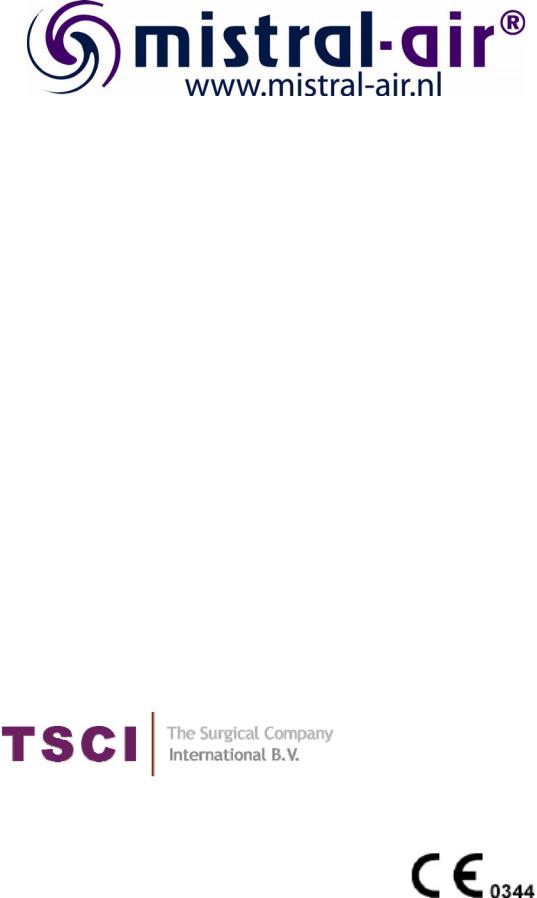
Technical Manual
Mistral-Air® Plus Warming Unit
MA1100-EU (220-240V~,50/60Hz)
MA1100-US (110-120V~,60Hz)
MA1100-JP (100-110V~,50/60Hz)
Beeldschermweg 6 F
3821 AH Amersfoort
The Netherlands
T: +31(0)33 450 7250
F: +31(0)33 450 7260 contact@tsci.nl www.tsci.nl
INT/R298-EN/1-11/09
INT/R298-EN/1-11/09 |
2 |
|
Foreword |
................................................................................................... |
|
5 |
|
Disclaimer ................................................................................................. |
|
5 |
||
1 |
Temperature .................................................................Management |
6 |
||
2 |
Forced ...........................................................................Air Warming |
6 |
||
3 Description .................................of Mistral-Air® Plus warming unit |
7 |
|||
|
3.1 ........................................................................... |
The Appliance |
7 |
|
|
3.2 ..................................................................... |
The Control Panel |
8 |
|
|
3.2.1 ..................................................................... |
Extra Options |
9 |
|
|
3.3 ............................................................................. |
The Blankets |
9 |
|
4 Preparing ....................the Mistral-Air® Plus warming unit for use |
10 |
|||
5 Mounting .................................the Mistral-Air® Plus warming unit |
10 |
|||
6 |
User Instructions.............................................................................. |
11 |
||
|
6.1 ...................................................Connection to Power Supply |
11 |
||
|
6.2 ...................................................................... |
Activate the Unit |
11 |
|
|
6.3 ........................................................... |
Connecting the Blanket |
12 |
|
|
6.4 ................Warming up with the Mistral-Air Plus warming unit |
12 |
||
|
6.4.1 ....................................................... |
Temperature settings |
12 |
|
|
6.4.2 ..................................................... |
Temperature Selection |
12 |
|
|
6.5 ......................................................................... |
Stop Warming |
13 |
|
7 |
Maintenance...................................................................................... |
14 |
||
8 |
Storage .......................................................................and Cleaning |
14 |
||
9 |
Warnings, ..............................................Precautions and Symbols |
14 |
||
10 |
Contra ............................................................................-indications |
14 |
||
11 |
Safety ...........................................................................precautions |
15 |
||
12 |
Symbols ............................................................................................ |
|
15 |
|
13 |
General ....................................................Description of Hardware |
19 |
||
|
13.1 ............................................................................... |
|
Housing |
19 |
|
13.2 ............................................................................. |
|
Top Plate |
19 |
|
13.3 ................................................................... |
|
Heating System |
19 |
|
13.4 ....................................................................... |
|
Blower Motor |
19 |
|
13.5 .................................. |
|
Power Supply & Electronic Hardware |
19 |
14 |
Safety .............................................................Systems and Alarms |
20 |
||
|
14.1 .................................................................... |
|
General Alarms |
20 |
|
14.2 ......................................................... |
|
Other Safety Features |
21 |
15 |
Temperature .............................& Temperature Alarm Calibration |
21 |
||
|
15.1 ...................................................... |
|
Temperature Calibration |
21 |
|
15.2 ............................................ |
|
Temperature Alarm Calibration |
23 |
16 |
Replacing ..........................................................................the Filter |
24 |
||
17 |
Reset .......................................................................the Hour Meter |
25 |
||
18 |
Repair ...........................................................................Procedures |
25 |
||
|
18.1 ........................................................... |
|
Routine Maintenance |
25 |
19 |
Troubleshooting ............................................................................... |
26 |
||
20 |
Parts ...........................................................................Replacement |
28 |
||
|
20.1 ............................................................. |
|
Replacing the Hose |
28 |
|
20.2 ............................................................ |
|
Replacing the Fuses |
28 |
INT/R298-EN/1-11/09 |
3 |
|
|
20.3 |
Replacing the Fan ............................................................... |
28 |
|
20.4 |
Replacing the Power Cord................................................... |
29 |
|
20.5 |
Record findings at paragraph .............................................. |
29 |
|
20.6 |
Replacing the Heater........................................................... |
29 |
21 |
After Service Test Protocols............................................................ |
30 |
|
|
21.1 |
Control board test ................................................................ |
30 |
|
21.2 |
Set point temperature test ................................................... |
30 |
|
21.3 |
Alarm tests .......................................................................... |
31 |
|
21.4 |
Electrical safety test............................................................. |
32 |
22 |
After Service Test Form ................................................................... |
33 |
|
|
22.1 |
Control Board Test .............................................................. |
33 |
|
22.2 |
Set point temperature check................................................ |
33 |
|
22.3 |
Alarm tests .......................................................................... |
33 |
|
22.4 |
Electrical Safety................................................................... |
33 |
23 |
Electromagnetic Compatibility ........................................................ |
34 |
|
|
23.1 |
Electromagnetic immunity.................................................... |
34 |
|
23.2 |
Electromagnetic Emissions.................................................. |
36 |
|
23.3 |
Recommended Separations Distances................................ |
37 |
24 |
Illustrations....................................................................................... |
38 |
|
|
24.1 |
Disassembly of the Mistral-Air® Plus warming unit............... |
38 |
|
24.2 |
Assembly of the Mistral-Air® Plus warming unit. .................. |
41 |
|
24.3 |
The Power Controller Board (PCB)...................................... |
42 |
|
24.4 |
Wiring Diagram.................................................................... |
43 |
25 |
Spare Parts and Order List .............................................................. |
44 |
|
26 |
Warranty............................................................................................ |
45 |
|
27 |
Specifications ................................................................................... |
46 |
|
INT/R298-EN/1-11/09 |
4 |
|
Foreword
Congratulations on your purchase of the Mistral-Air® Plus Forced Air Warming Unit.
This device was developed with and for users and was built in accordance to the latest safety standards.
We wish you every success in preventing and controlling hypothermia and
are sure the Mistral-Air Plus warming unit can help you to do so.
Please read this manual carefully before using the Mistral-Air® Plus warming unit.
If you identify any improvements and/or discover any other applications during the use of the Mistral-Air® products, please let us know.
The Surgical Company International B.V. (TSCI)
Disclaimer
All rights reserved. No part of this document may be reproduced or published, electronically, mechanically, in print, photographic print, on microfilm or by any other means whatsoever, without the explicit consent of TSCI.
The content of this document has been compiled with the greatest possible care and this information can be regarded as reliable. Nevertheless,
TSCI is not liable for any consequences arising from the use of the manual.
TSCI reserves the right to make alterations and improvements to the device. These cannot yet be described in the instructions. TSCI B.V. cannot be held liable for the final outcome of the patients’ treatment.
This document contains information that may not be published to third parties. This document may not be used without the explicit written consent of TSCI.
These instructions are intended for personnel authorised to work with and/or service the medical device mentioned in this manual.
INT/R298-EN/1-11/09 |
5 |
|
1 Temperature Management
Hypothermia, an abnormal drop in body temperature, is a threat to human life. Hospital patients in particular run serious risks if their body temperature falls below 36 ºC. The risk of hypothermia is particularly high at moments when they are vulnerable, such as pre-, per-, and post-surgical interventions. Factors that can contribute to hypothermia include the duration of the surgical intervention, the location of the wound, the amount of blood loss, the surface area of the wound, the environmental temperature and the anaesthetic technique.
2 Forced Air Warming
Forced air warming is a widely used and clinically accepted intervention for the prevention of hypothermia and/or re-warming of the postoperative surgical patient. The principle of operation for forced air warming systems is an electrically powered unit consisting of a fan and heating element that propels warmed air via a flexible hose to a blanket draped over the patient. Some configurations allow for the patient to be placed on top of the blanket or surrounded by a warming tube.
All of these forced air warming systems are intended to distribute warmed air to the patient in a manner that is safe and effective.
INT/R298-EN/1-11/09 |
6 |
|
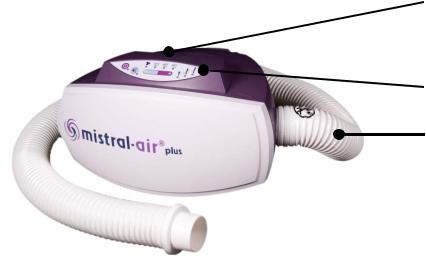
3 Description of Mistral-Air® Plus warming unit
The Mistral-Air® Plus warming unit is a system which is intended for use in preventing patients from getting hypothermic.
The Mistral-Air® Plus warming unit should be used with disposable Mistral-Air® blankets that are single patient use only.
3.1The Appliance
Handle, at top side
Control panel
Hose towards patient/blanket
The Mistral-Air® Plus warming unit can be controlled by using the control panel at the front top of the unit. The clamp to fix the Mistral-Air® Plus warming unit to a stand is positioned at the back of the unit.
Article number: - MA1100-EU (220-240V~,50/60Hz)
-MA1100-US (110-120V~,60Hz)
-MA1100-JP (100-110V~,50/60Hz)
INT/R298-EN/1-11/09 |
7 |
|
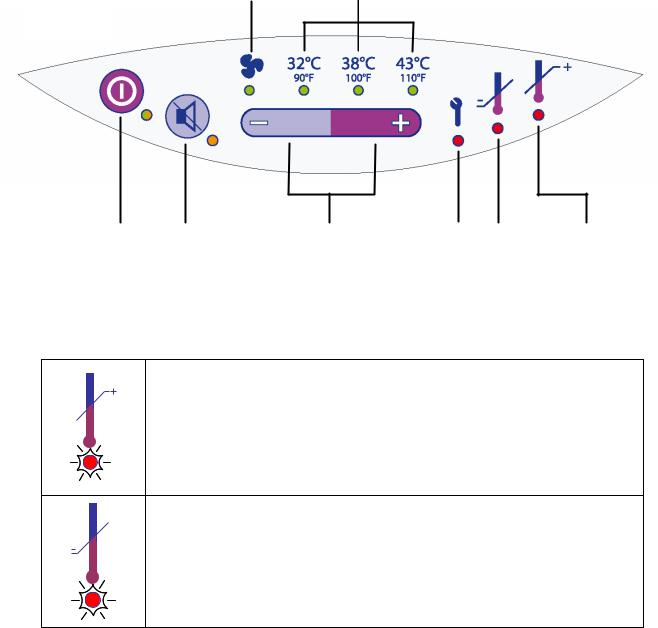
3.2The Control Panel
The control panel is located at the front top of the unit and can be controlled by pressure sensitive buttons.
The Mistral-Air® Plus warming unit is very easy to use. All settings are visible on the control panel and you can select the preferred temperature by pressing the Temperature Selection button.
In emergencies, an audible alarm will be activated and an L.E.D. will flash or glow solid red.
Temperature Selection
Fan / Ambient air Indicator
Indicator
Stand-by |
Audible |
Temperature |
Service |
Under Temp Over Temp |
|
button |
Alarm |
Selection |
Indicator |
alarm |
alarm |
|
Suppression |
button |
|
|
|
button
Explanation of temperature alarm indications:
Alarm: An audible alarm is activated and the L.E.D. flashes or glows red.
- The primary alarm gives a flashing red L.E.D. - The secondary alarm gives a solid red L.E.D.
Cause: There is an over temperature.
Alarm: The L.E.D. flashes red.
Cause: There is an under temperature.
INT/R298-EN/1-11/09 |
8 |
|
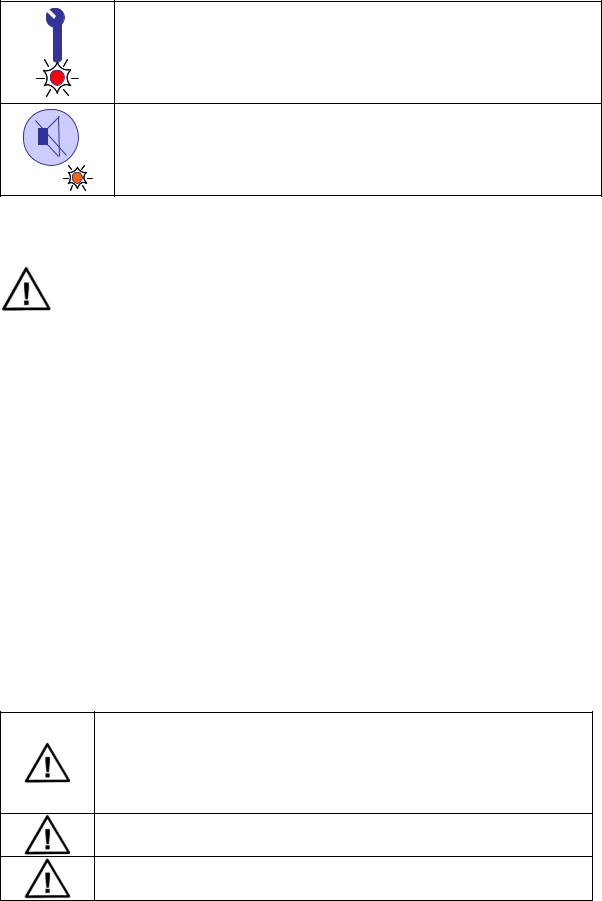
3.2.1Extra Options
Alarm: The L.E.D. is solid red.
Cause: The Mistral-Air® Plus warming unit has been used for ≥ 500 hours and routine maintenance is required.
The audible alarm can be suppressed for 3 minutes by
pressing the  button. Audible alarm suppression is indicated by a solid orange L.E.D. After 3 minutes, the audible alarm will be activated again.
button. Audible alarm suppression is indicated by a solid orange L.E.D. After 3 minutes, the audible alarm will be activated again.
3.3The Blankets
Do not use the Mistral-Air® Plus warming unit with any forced air disposables other than Mistral-Air® blankets. Thermal Injury may result.
Mistral-Air® blankets come in a variety of designs and sizes to meet the customers’ needs for preventing and treating hypothermia.
All Mistral-Air® blankets are:
Latex free
Made from non-woven polypropylene or polyethylene
Manufactured to meet flammability standards
MR Conditional
Not obstructing x-ray
Non-conductive
Non-sterile, except for several dedicated blankets (ask your distributor)
Packed including an insert in the main languages
Single-patient use only
Made from lightweight, soft materials that have been approved for skin contact
Mistral-Air® blankets need to be used with the soft blue material towards the patient’s skin and the white or reflective layer away from the patient’s skin. The blue side provides the air distribution towards the patient.
Never fold the blankets during use
Thermal injury may occur if heat is applied to ischemic limbs.
INT/R298-EN/1-11/09 |
9 |
|

4 Preparing the Mistral-Air® Plus warming unit for use
Before using the Mistral-Air® Plus warming unit, it should be attached to a stand or placed on a table.
Prior to use, the user needs to check that the MistralAir® Plus warming unit, the power cord and the hose are undamaged. In the event of damage do not use the Mistral-Air® Plus warming unit.
Plug the Mistral-Air® Plus warming unit into an earthed socket.
If required, a safety test in accordance with the hospital protocol will follow.
5 Mounting the Mistral-Air® Plus warming unit
The Mistral-Air® Plus warming unit must be mounted securely before use.
The Mistral-Air® Plus warming unit can be mounted onto the Mistral-Air® pole with basket (art. MA5100-B).
The unit should be clamped onto the pole with the top of the clamp less than 80 cm above the floor to prevent tipping over.
Avoid blocking the air inlet (bottom of unit)
It is also possible to place the Mistral-Air® Plus warming unit on a table. Do not place the unit in the bed with the patient.
Mistral-Air® pole with basket
Art. MA5100-B
INT/R298-EN/1-11/09 |
10 |
|
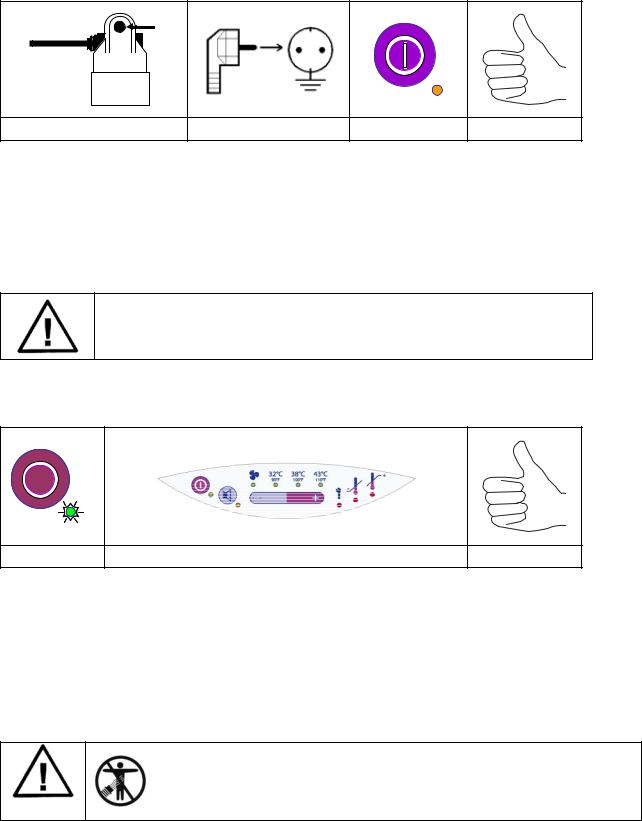
6 User Instructions
When using the Mistral-Air® Plus warming unit, the instructions below may be useful.
6.1Connection to Power Supply
a |
b |
c |
d |
a.Make sure the power cord is secured by the cord anchor.
b.Plug the unit into an earthed socket.
c.The unit automatically switches to Stand-by mode, which is indicated by the orange Stand-by L.E.D.
d.The Mistral-Air® Plus warming unit is now in Stand-by mode.
To remove all power from the Mistral-Air® Plus warming unit, the mains power cord must be removed from the electrical receptacle.
6.2Activate the Unit
a |
b |
c |
a.Activate the Mistral-Air® Plus warming unit by pressing the Stand-by button.
b.The Mistral-Air® Plus warming unit will now perform a self-test, which includes a flash of all the L.E.D’s and a short audible alarm.
c.The Mistral-Air® Plus warming unit will start blowing air at the default temperature setting of 38 ˚C.
Do not use the Mistral-Air® Plus warming unit without a Mistral-Air® blanket connected to it.
INT/R298-EN/1-11/09 |
11 |
|

6.3Connecting the Blanket
a |
b |
c |
a.Take the blanket out of the (sterile) package and place it on the patient.
b.Unfold the blanket over the patient.
c.Insert the end of the flexible hose into the air inlet port of the
Mistral-Air blanket. Make sure the hose is fully pushed in. Detailed instructions are mentioned on the inserts delivered with the
Mistral-Air blankets.
6.4Warming up with the Mistral-Air Plus warming unit
6.4.1Temperature settings
The four settings are:
Fan - Ambient air
32 ºC - Low temperature
38 ºC - Medium temperature
43 ºC - High temperature
6.4.2Temperature Selection
The Mistral-Air® Plus warming unit will start up with the default temperature setting of 38 ºC.
By pressing the “–“ button twice, the Mistral-Air® Plus will activate the unit to draw in room temperature air and deliver it to the patient via the blanket. The heater will not be activated.
The temperature to the patient will depend on ambient conditions and possible heat from the blower motor.
By pressing the “+” of the temperature selection button the Mistral-Air® Plus will activate the heater to deliver the set temperature: 32 ºC, 38 ºC or 43 ºC.
INT/R298-EN/1-11/09 |
12 |
|
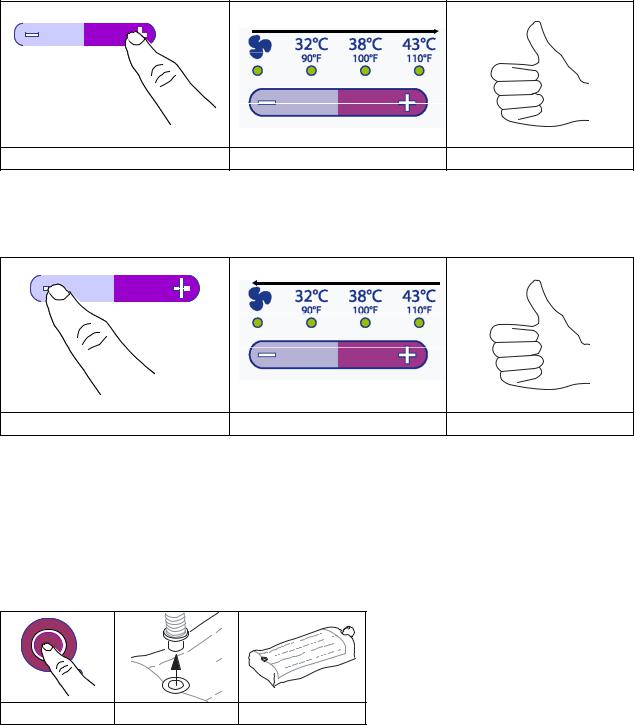
By pressing the “+” of the temperature selecting button, the temperature setting increases. This is indicated by a green L.E.D.:
a |
c |
c |
By pressing the “-” of the Temperature Selecting Button, the temperature setting decreases. This is indicated by a green L.E.D.:
a |
b |
c |
After selecting the desired temperature, the L.E.D. below the Temperature Indicator will flash green. After reaching the set temperature (+ 2 ˚C) the flashing L.E.D. will light up permanently.
6.5Stop Warming
a |
b |
c |
a.Press the Stand-by button
b.Disconnect the hose from the blanket
c.If desired, leave the blanket on the patient
INT/R298-EN/1-11/09 |
13 |
|
7 Maintenance
The Mistral-Air Plus warming unit has no parts that can be maintained by
users. Users should not repair or open the Mistral-Air Plus warming unit in the event of a malfunction. This can damage the appliance and will invalidate the guarantee. The hospital service department or the local supplier should service the Mistral-Air® Plus warming unit when the service indicator is activated or at least once a year.
Have the Mistral-Air Plus warming unit serial number ready when you contact the hospital service department or the local supplier for technical support. The serial number is located on the bottom of the unit.
8 Storage and Cleaning
Store the Mistral-Air Plus warming unit and accessories in a cool and dry place when not in use.
Clean the unit by wiping the outer surface (including the hose) with a soft cloth lightly dampened with a solution of water and mild detergent or a nonstaining hospital disinfectant.
Wipe all excess detergent or disinfectant from the unit and allow to air dry. Do not use alcohol or acid base cleaner on the control panel.
Disconnect from power when cleaning the Mistral-Air® Plus warming unit. Do not use dripping wet cloths and do not allow water to seep into electrical
areas of the Mistral-Air Plus warming unit.
9 Warnings, Precautions and Symbols
Your Mistral-Air® Plus warming unit was designed and built with safety in mind. The unit should provide reliable service and high quality patient care. However, there is no replacement for care providers being attentive to their patients’ needs and equipment operation. Read and understand all warnings and precautions before using / prescribing the Mistral-Air® Plus warming unit
10 Contra-indications
Do not apply heat directly to open wounds. All patients’ wounds should be covered while using the warming system. Do not apply the warming system to ischemic limbs. Use caution and consider discontinuing use on patients during vascular surgery when an artery is clamped to an extremity (i.e. aortic cross-clamping). Use caution and monitor closely if used on patients with severe peripheral vascular disease.
INT/R298-EN/1-11/09 |
14 |
|
